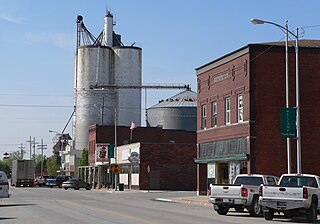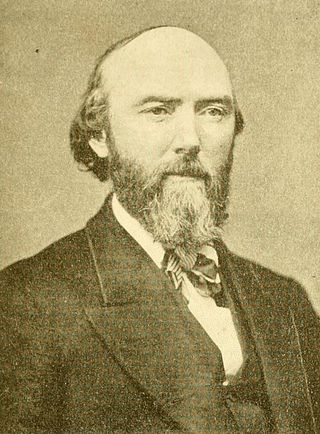Related Research Articles

The Kansas–Nebraska Act of 1854 was a territorial organic act that created the territories of Kansas and Nebraska. It was drafted by Democratic Senator Stephen A. Douglas, passed by the 33rd United States Congress, and signed into law by President Franklin Pierce. Douglas introduced the bill intending to open up new lands to develop and facilitate the construction of a transcontinental railroad. However, the Kansas–Nebraska Act effectively repealed the Missouri Compromise of 1820, stoking national tensions over slavery and contributing to a series of armed conflicts known as "Bleeding Kansas."

The Underground Railroad was used by freedom seekers from slavery in the United States and was generally an organized network of secret routes and safe houses. Enslaved Africans and African Americans escaped from slavery as early as the 16th century and many of their escapes were unaided, but the network of safe houses operated by agents generally known as the Underground Railroad began to organize in the 1780s among Abolitionist Societies in the North. It ran north and grew steadily until the Emancipation Proclamation was signed in 1863 by President Abraham Lincoln. The escapees sought primarily to escape into free states, and from there to Canada.

Nuckolls County is a county located in the U.S. state of Nebraska. As of the 2020 United States Census, the population was 4,095. Its county seat is Nelson.

Hamburg is a city in Fremont County, Iowa, United States, that is the most southwestern city in Iowa, hugging the borders of Missouri to the south and Nebraska to the west. It is situated between the Nishnabotna and Missouri rivers. The population was 890 at the time of the 2020 census. It derives its name from the German city of Hamburg.

North Bend is a city in Dodge County, Nebraska, United States. The population was 1,177 at the 2010 census.

Oak is a village in Nuckolls County, Nebraska, United States. The population was 66 at the 2010 census.

Nebraska City is a city in Nebraska and the county seat of Otoe County, Nebraska, United States. As of the 2020 census, the city population was 7,222.

Tabor is a city in Fremont County and extends northward into Mills County in the U.S. state of Iowa. The population was 1014 at the time of the 2020 census.

Bleeding Kansas, Bloody Kansas, or the Border War, was a series of violent civil confrontations in Kansas Territory, and to a lesser extent in western Missouri, between 1854 and 1859. It emerged from a political and ideological debate over the legality of slavery in the proposed state of Kansas.

In the United States, fugitive slaves or runaway slaves were terms used in the 18th and 19th centuries to describe people who fled slavery. The term also refers to the federal Fugitive Slave Acts of 1793 and 1850. Such people are also called freedom seekers to avoid implying that the enslaved person had committed a crime and that the slaveholder was the injured party.

Josiah Bushnell Grinnell was a U.S. Congressman from Iowa's 4th congressional district, an ordained Congregational minister, radical abolitionist, founder of Grinnell, Iowa and benefactor of Grinnell College.

The Nishnabotna River is a tributary of the Missouri River in southwestern Iowa, northwestern Missouri and southeastern Nebraska in the United States. It flows for most of its length as two parallel streams in Iowa, the East Nishnabotna River and the West Nishnabotna River. The east and west branches are each about 120 miles (190 km) long; from their confluence the Nishnabotna flows approximately another 16 miles (26 km).

The state of Iowa played a significant role during the American Civil War in providing food, supplies, troops and officers for the Union army.
The history of slavery in Nebraska is generally seen as short and limited. The issue was contentious for the legislature between the creation of the Nebraska Territory in 1854 and the outbreak of the American Civil War in 1861.

Stephen Friel Nuckolls was a Delegate from the Territory of Wyoming and co-founder of Nebraska City, Nebraska. Nuckolls County, Nebraska is named after him.

Alfred D. Jones was a late 19th-century lawyer, surveyor and politician in the Midwestern United States. In 1846 he platted Fort Des Moines, Iowa, and in 1854 he platted Omaha, Nebraska. He became the first settler in Omaha, as well as the first postmaster, a member of the first Omaha City Council and the first Omaha School Board, and was among the first legislators of the Nebraska Territory.

The Underground Railroad in Indiana was part of a larger, unofficial, and loosely-connected network of groups and individuals who aided and facilitated the escape of runaway slaves from the southern United States. The network in Indiana gradually evolved in the 1830s and 1840s, reached its peak during the 1850s, and continued until slavery was abolished throughout the United States at the end of the American Civil War in 1865. It is not known how many fugitive slaves escaped through Indiana on their journey to Michigan and Canada. An unknown number of Indiana's abolitionists, anti-slavery advocates, and people of color, as well as Quakers and other religious groups illegally operated stations along the network. Some of the network's operatives have been identified, including Levi Coffin, the best-known of Indiana's Underground Railroad leaders. In addition to shelter, network agents provided food, guidance, and, in some cases, transportation to aid the runaways.

John Henry Kagi, also spelled John Henri Kagi, was an American attorney, abolitionist, and second in command to John Brown in Brown's failed raid on Harper's Ferry. He bore the title of "Secretary of War" in Brown's "provisional government." At age 24, Kagi was killed during the raid. He had previously been active in fighting on the abolitionist side in 1856 in "Bleeding Kansas". He was considered an excellent debater and speaker.

McKissick Island is a former island in the Missouri River that is part of Nemaha County, Nebraska, United States. It is now fully east of the river, which is Nebraska's normal eastern border, and it can only be reached by land from mainland Nebraska by first going through Iowa and Missouri.
Slavery occurred in Iowa prior to 1846, but the extent and significance of slavery in pre-state Iowa is poorly understood. Little is known about slavery in Iowa prior to the Louisiana Purchase. The area that is now the American state of Iowa was part of New France when first settled by Europeans. As such, it was governed by its slavery laws. French settlers first brought African slaves into Upper Louisiana from Saint-Domingue around 1720 under the legal terms of the Code Noir, which defined the conditions of slavery in the French empire and restricted the activities of free Black persons.
References
- ↑ Handy, Robert (2000). "Civil Bend : legend of reality". search.worldcat.org. Retrieved February 8, 2024.
- ↑ "Underground Railroad". State Historical Society of Iowa. Archived from the original on December 23, 2023. Retrieved February 8, 2024.
- ↑ "Fremont County Iowa, township history". iagenweb.org. Archived from the original on February 9, 2024. Retrieved February 9, 2024.
- 1 2 "Elvira Gaston Platt papers," (Reference identifier: IWA0181) University of Iowa.
- ↑ ""Fremont County Iowa, Underground Railroad"". iagenweb.org. Archived from the original on February 9, 2024. Retrieved February 9, 2024.
- ↑ "Civil Bend, Iowa, described in 1850". The Burlington Hawk-Eye. September 11, 1851. p. 2. Retrieved February 8, 2024.
- ↑ "Todd, John". The Biographical Dictionary of Iowa, The University of Iowa Libraries. Archived from the original on February 9, 2024. Retrieved February 9, 2024.
- 1 2 State Historical Society of Iowa; Iowa Department of Cultural Affairs; The National Underground Railroad Network to Freedom. "Civil Bend, Fremont County, Iowa: Spoiling slavery on the Missouri slope". Find A Grave. Archived from the original on February 8, 2024. Retrieved February 8, 2024.
- ↑ Todd, John (1906). Early settlement and growth of western Iowa; or, Reminiscences. Allen County Public Library Genealogy Center. Des Moines, The Historical department of Iowa.
- ↑ "Iowa Freedom Trail Project: Individuals by County" (PDF). State Historic Society of Iowa. Archived (PDF) from the original on February 8, 2024. Retrieved February 9, 2024.
- ↑ Miller, Diane (May 2008). "To Make Kansas Free: The Underground Railroad in Bleeding Kansas" (PDF). National Park Service. Archived from the original on February 8, 2024. Retrieved February 8, 2024.
- ↑ "The Underground Railroad in Iowa: Linn County's role in helping escaped slaves continues to evolve". www.thegazette.com. Archived from the original on February 9, 2024. Retrieved February 9, 2024.
- ↑ "Civil Bend called one of Lane's "horse and negro stations."". The Niles Democrat. October 3, 1857. p. 2. Retrieved February 8, 2024.
- ↑ "Excitement on the Iowa Borders". Wisconsin Tribune. December 28, 1858. p. 2. Retrieved February 8, 2024.
- ↑ "Nebraska Negro Catchers in Iowa". The Weekly Hawk Eye. January 25, 1859. p. 2. Retrieved February 8, 2024.
- ↑ "Slavery in Nebraska". Wisconsin State Journal. December 16, 1859. p. 2. Retrieved February 8, 2024.
- ↑ "Heavy Damages". Muscatine Evening Journal. June 9, 1860. p. 2. Retrieved February 8, 2024.
- ↑ "Three Negroes Kidnapped Near Council Bluffs and Run into Missouri -- Great Excitement". Burlington Weekly Hawk-Eye. October 6, 1860. p. 1. Retrieved February 8, 2024.
- ↑ Leopard, John C.; Hillman, Mary McCammon; McCammon, Robert McMillen (1922). History of Daviess and Gentry counties, Missouri. The Internet Archive. Topeka : Historical Pub. Co. p. 103.
- ↑ "Captain Folmsbee in Command of the Civil Bend company". The North Missourian. October 27, 1864. p. 2. Retrieved February 8, 2024.
- ↑ "New Church". The North Missourian. February 6, 1868. p. 4. Retrieved February 8, 2024.
- ↑ Jensen, Richard E. (2004). "1,000 Miles From Home on the Wild Prairie‟: Charles B Darwin‟s 1849 Nebraska Diary" (PDF). Nebraska History. 85: 58–114. Archived from the original (PDF) on February 8, 2024 – via Nebraska State Historical Society.
- ↑ "The Underground Railroad" by Diane Miller for the Oxford Research Encyclopedia on 19 October 2022. https://doi.org/10.1093/acrefore/9780199329175.013.974. Retrieved February 3, 2023.
- ↑ "Civil Bend (IA)". United States Army Corps of Engineers, Missouri River Recovery Program. Archived from the original on February 8, 2024. Retrieved February 8, 2024.
